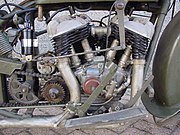Engine
Almost all commercially available motorcycles are driven by conventional gasoline internal combustion engines, but some small scooter-type models use an electric motor, and a very small number of diesel models exist (e.g., the USMC M1030 M1 version of the Kawasaki KLR650 and the Dutch-produced Track T-800CDI).
The displacement is defined as the total volume of air/fuel mixture an engine can draw in during one complete engine cycle. In a piston engine, this is the volume that is swept as the pistons are moved from top dead centre to bottom dead centre. To the layperson this is the "size" of the engine. Motorcycle engines range from less than 50 cc (cubic centimetres), commonly found in many small scooters, to 5735 cc, a Chevrolet V8 engine, currently used by Boss Hoss in its cruiser style motorcycle.
Motorcycles have mostly, but not exclusively, been produced with one to four cylinders, and designers have tried virtually every imaginable layout. The most common engine configurations today are the vertical single and twin, the V-twin, the opposed twin (or boxer), and the in-line triple and in-line four. A number of others designs have reached mass production, including the V-4, the flat 6-cylinder, the flat 4-cylinder, the in-line 6-cylinder, and the Wankel engine. Exotic engines, such as a radial piston engine, sometimes appear in custom built motorcycles.
Engines with more cylinders for the same displacement feel smoother to ride. Engines with fewer cylinders are cheaper, lighter, and easier to maintain. Liquid-cooled motorcycles have a radiator (exactly like the radiator on a car) which is the primary way their heat is dispersed. Coolant or oil is constantly circulated between this radiator and the cylinder when the engine is running. Air-cooled motorcycles rely on air blowing past fins on the engine case to disperse heat. Liquid cooled motorcycles have the potential for greater power at a given displacement, tighter tolerances, and longer operating life, whereas air cooled motorcycles are potentially cheaper to purchase, less mechanically complex and lighter weight.
An air cooled engine contracts and expands with its wider temperature range, requiring looser tolerances, and giving shorter engine life. The temperature range of an air cooled two stroke is even more extreme, and component life even shorter than in an air cooled four stroke.
As applied to motorcycles, two-stroke engines have some advantages over equivalent four-strokes: they are lighter, mechanically much simpler, and produce more power when operating at their best. But four-stroke engines are cleaner, more reliable, and deliver power over a much broader range of engine speeds. In developed countries, two-stroke road-bikes are rare, because - in addition to the reasons above - modifying them to meet contemporary emissions standards is prohibitively expensive. Almost all modern two-strokes are single-cylinder, liquid-cooled, and under 600 cc.
Created By :- Muhammad Taufan (12062534)
- Ahmad Baidhowi (12062519)
- Adhi Sutanto (12062276)
- Andi Purwantoro (12062523)
- Asep Rosyidin (12062464)



No comments:
Post a Comment